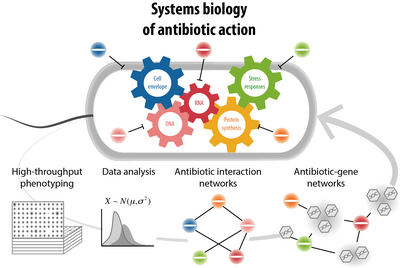Systems biology of antibiotic action
The Brochado Lab uses high-throughput approaches to study antimicrobial mode of action, and decipher how bacterial molecular networks re-wire in response to multi-antibiotic therapies. We will focus on generating mechanistic insight into antibiotic tolerance and persistence by Gram-negative pathogens.

Previous research
Prevalent and widespread antibiotic resistance urges the development of new efficient strategies against infectious diseases. Antibiotic combinations provide an attractive alternative for overcoming the current antibacterial crisis. We recently profiled drug combinations in a high-throughput manner against several Gram-negative pathogens, including high priority pathogens such as Pseudomonas aeruginosa (Brochado et al, Nature 2018). In this study we revealed a number of general principles driving drug interactions, and illustrated how to use such a large data set to uncover the molecular mechanisms underlying drug interactions and drug mode of action. Finally, we demonstrated the clinical relevance of our study by exposing a handful of novel synergies active against multi-drug resistant clinical isolates.
Future directions
We will deepen our understanding of antimicrobials mode of action, as well as their synergies and antagonisms. On one hand, we will develop novel high-throughput methodologies that go beyond detecting bacterial growth, in order to systematically study other important features of drug action such as drug tolerance and persistence. Special attention will be devoted to drug action in infection, where we will use S. Typhimurium as a model pathogen to investigate the impact of host-pathogen interactions in drug activity. On the other hand, we will pursue detailed mechanistic work of pathogen-specific drug synergies, e.g. those selectively potent against resistant pathogens, such as P. aeruginosa. Along the way, we will use reverse genetic approaches and make use of bacterial mutant collections (gene deletion and overexpression) to reveal what, and how, specific bacterial pathways are pertinent to drug activity. Detailed mechanistic work will follow, using conventional molecular biology and biochemistry techniques. We are very much interested in expanding our drug collection to include human targeted drugs, food ingredients and natural compounds, in addition to commonly used antimicrobial molecules.








